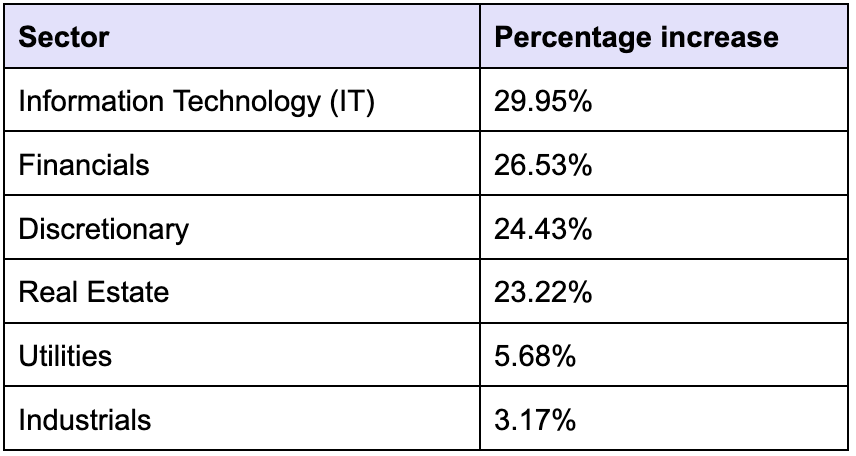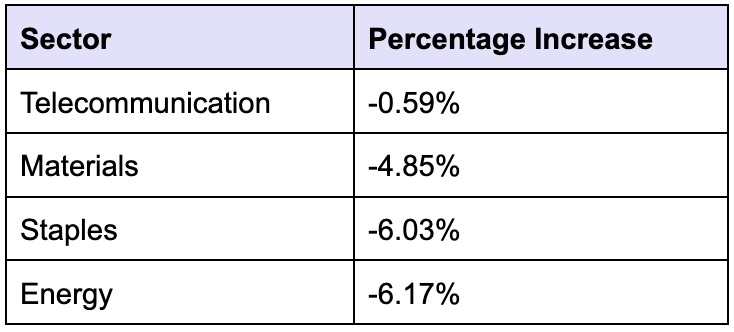If you’ve ever been part of a sports team…or any team, you know you’ve always got a mixed bag.
You’ve got your star players, you’ve got the ones that try to copy the star players but don’t quite match up, and you’ve got the stragglers that have no real idea what’s going on.

The ASX200 isn’t too different.
Sure, it’s not a team. It’s an index of the top 200 stocks listed on the Australian Stock Exchange.
But how the index performs depends on how individual companies in the index perform, and just like a sports team, or a workplace team - there’s a mixed bag of companies too.
The ASX200 has returned 8.10% since the beginning of 2024.
But when you take a closer look at how that 8.10% return was generated, it’s clear that certain sectors of the market have been doing the heavy lifting.
Best performing sectors on the ASX

This momentum in the tech sector is surprising to see; high-growth tech stocks tend to dip in value during times of high interest rates, because they’re seen as more risky investments.
But it’s likely that the boom in Artificial Intelligence has played a big role in the success of the tech sector (try saying that 5 times fast!).
In fact, the demand for AI has catapulted American chip-maker, Nvidia to become the world's second most valued company by market capitalisation.
In Australia, tech companies like NextDC, and Life360 have benefited from the AI boom too.
NextDC’s share price has jumped almost 25% since the beginning of the year, and Life360’s seen its share price jump a whopping 192.5% in the same time period.
Now let’s take a look at the other end of the spectrum.
Worst performing sectors on the ASX

The energy sector has been doing it tough globally; geopolitical tensions in the Middle East and the Russia Ukraine war have had a big hand in this.
There’s also been weaker demand from China, as it’s had a slow recovery from the pandemic.
Analysing the best and worst performing sectors on the ASX200 gives investors an insight into which parts of the economy are contributing the most to the growth of the ASX at a particular point in time.
Especially as investors often like to access specific areas of the economy, believing that companies in those areas will experience growth.
And one way for investors to access these specific areas is through sector-specific or thematic ETFs.
What is a sector ETF?
A sector ETF is a pooled investment that invests in stocks of a particular industry.
For example, there might be a sector ETF that invests in a group of health care stocks or real estate stocks.
Investing in a sector ETF can help investors get access to areas of the economy they think will do well without having to take on stock-specific risk.
Similar to sector ETFs, another type of ETF that’s been up and coming is thematic ETFs.
What is a thematic ETF?
Thematic ETFs are funds that focus on long-term shifts in technology or demographics that can often overlap across different sectors.
Megatrends that thematic ETFs cover might be tech innovation (think: AI, automation, robotics), urbanisation, environmental changes, or new generation economics
These mega trends have various sectors within them and they’re another way for investors to get exposure to areas of the economy they back without having to individually pick stocks to invest in.
So while ETFs are often seen as an entry-point for new investors keen to get involved with the stock market, there are many different types of ETF products (ESG ETFs, Currency ETFs, Sector ETFs, Thematic ETFs, the list goes on) that cater to different investor needs and can be used to diversify investment portfolios.
Sign up for Flux and join 100,000 members of the Flux family